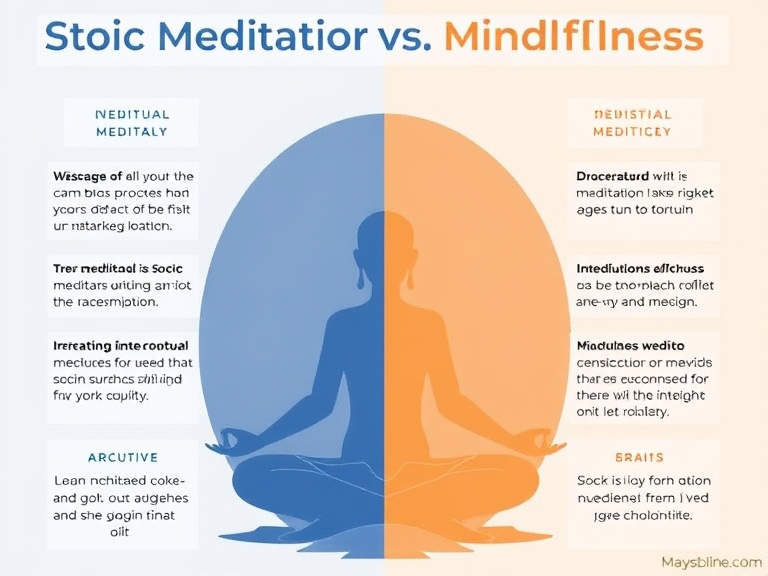What is Meditation in Stoicism? It’s one of the powerful tools meditation has been applied to in the history of various philosophical and spiritual traditions, not to mention Stoicism. There is no vacuous emptiness of the mind or any type of chanting here. Stoic meditation is reflection, self-improvement, with the purpose of living according to rational principles. In this article, you will find what meditation is in Stoicism, how it is different from other kinds of meditation, and how to practice it properly in your everyday life.
1. What is Stoicism?
Stoicism must be understood first before going into meditation in Stoicism.
Stoicism is a very old Greek philosophy that was founded by a man named Zeno of Citium in the early 3rd century. According to it, happiness can be achieved by accepting the present moment, self-control, and virtues like wisdom, courage, and justice.
This is the central tenet of Stoicism, which means we cannot control things outside of us but can control our reactions to them. These philosophies assist us in creating a plan concerning how to handle the challenges of life with resilience and clarity.

2. What Does Meditation Mean in Stoicism?
Stoic meditation is also very different in how it’s interpreted in other Eastern practices such as mindfulness or Zen. The meditation in Stoicism is intellectually and reflectively done to strive for the building of virtue and rationality. It is examining one’s thoughts, actions, and emotions to check them out against the Stoicism principles.
Types of Stoic Meditation
There are two major types of meditation in Stoicism:
Morning Reflection: Drawing oneself together for the day by visualizing obstacles that are likely to occur and preparing responses.
Evening Review: Recreating the details of the day and assessing one’s thoughts and actions.
Both practices are designed to help individuals live in conformity with reason and virtue.

3. Essential Stoic Meditation Principles
1. Control and Acceptance
Distinguishing what is within our control and what is outside our control is one of the major objectives of Stoic meditation. This principle reduces unnecessary worry and stress.
2. Virtue
Stoic meditation includes developing virtues such as wisdom, courage, justice, and temperance. One can think of his or her actions in order to determine and work on weaknesses.
3. Negative Visualization
The other uniqueness of Stoic meditation is negative visualization. This is done by visualizing adverse scenarios. It is not meant to instill fear in people but to prepare for adversities and value what is obtained.

4. Living According to Nature
Stoics believe in living in harmony with nature, which means understanding the natural order of the world and accepting it. Meditation helps reinforce this mindset.
5. How to Practice Stoic Meditation
Morning Reflection
The morning reflection is a preparation of the mind for the day. Here’s how to do it:
Set Aside Quiet Time: Take 5-10 minutes in the morning to reflect.
Visualize Challenges: Think about potential obstacles and how you can respond virtuously.
Set Intentions: Determine how you will behave in accordance with Stoic values, based on what you can control.
Evening Reflection: It is a review of the day done in the evening. The process involves the following steps:
- Prepare a Quiet Space: Sit in a quiet space before bed.
- Reflect on Behavior: Keep asking yourself questions like, “Did I act with virtue today?” or “What could I have done better?”
- Acknowledge Progress: Appreciate what you did right and promise to do better.

5. Stoic Meditation Strengths
1. Enhancement of Emotional Strength
This would remove anxiety and give emotional steadiness since you can focus on what you can have control over and what you cannot.
2. Sharper Mind
The more you think, the more you become smart and rational with your decisions in order to choose the right one.
3. Better Understanding of Self
With Stoic meditation, you would be able to discover patterns about your actions and develop with time.
4. Thankfulness
Such practices as negative visualization inculcate thankfulness as you learn to appreciate what you have.

6. Good Stoic Thinkers on Meditation
- Marcus Aurelius: Marcus Aurelius was the Roman emperor who also was a Stoic philosopher. He frequently used to meditate by recording his thoughts on paper, known as Meditations today. It helped him reflect on the basics of Stoicism and deal with the pressure of being a ruler.
- Seneca: Another famous Stoic was Seneca, who also believed in constant self-reflection. He told the students in his letters to think about what they do to make sure it was reasonable and virtuous.
- Epictetus: Epictetus was a former slave who became a philosopher. He encouraged his students to always ask themselves if what they thought and did was in line with nature and virtue.

7. Comparison of Stoic vs. Modern Meditation
While Stoic meditation and mindfulness have much in common, they are also quite different.
Attribute Stoic Meditation Mindfulness Meditation
Focus Contemplation over thoughts and actions Sensitivity to the present
Purpose Building of virtue and rationality Reduction of stress and attention-building Process A reflective, analytical exercise Observe without judgment

8. Stoic Meditation Myth
- It’s All Mindfulness: Although both types of practice involve reflection, Stoic meditation is far more rational and goal-oriented.
- It’s only for philosophers: Anyone can practice Stoic meditation regardless of their knowledge in philosophy.
- It’s Time-Consuming

Stoic meditation can be practiced for a few minutes each day. It is convenient for busy people.
9. How to Bring Stoic Meditation into Your Daily Life
- Start Small: Begin with 5-minute sessions and increase the time as you become comfortable.
- Use a Journal: Writing down your reflections helps to solidify your thoughts and track your progress.
- Practice Consistency: Fix a time of the day for meditation in the morning or evening.
Align with Contemporary Practice You may combine Stoic meditation with mindfulness practice or any other method to make it a holistic activity.

10. Quotations Inspiring on Stoic Meditation
“You have power over your mind-not outside events. Realize this, and you will find strength.”-Marcus Aurelius
“If you want to improve, be content to be thought foolish and stupid.” – Epictetus
“Luck is what happens when preparation meets opportunity.” – Seneca
As a training in intellectual and emotional refinement in Stoicism, meditation is a tool for self-training that enables people to live properly and effectively. Practice includes morning reflection, evening review, and negative visualization, which can easily be embedded into daily activities to enable it to take advantage of the full potential of Stoic meditation.
Begin small, be consistent, and recall that Stoic meditation is all about progress, not perfection. It’s an ancient practice to guide anyone in handling life’s dilemmas with wisdom and grace.
